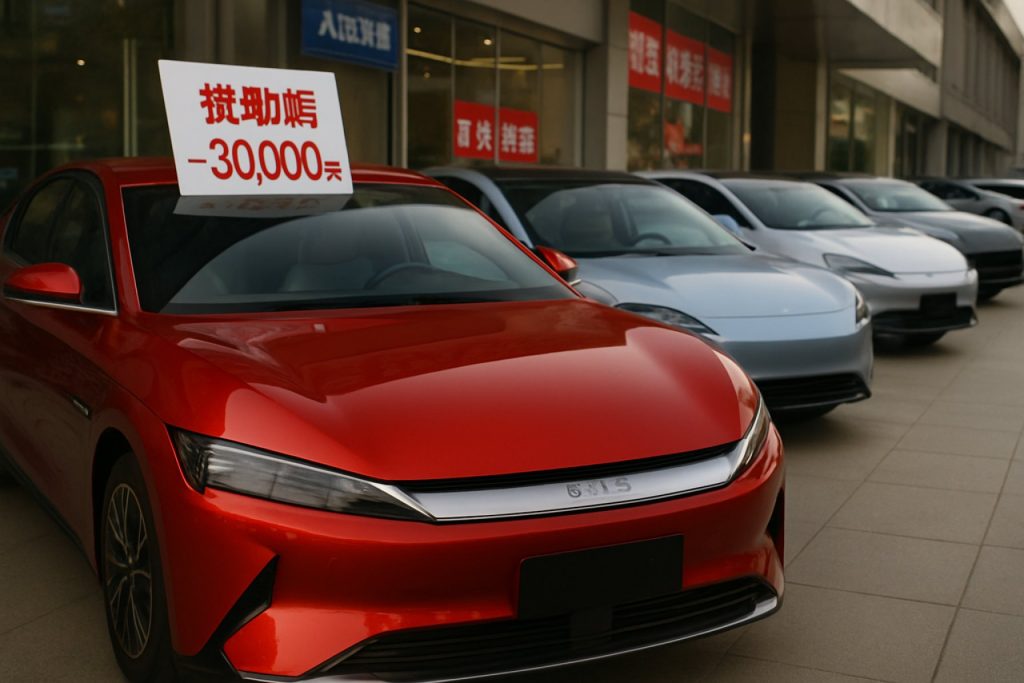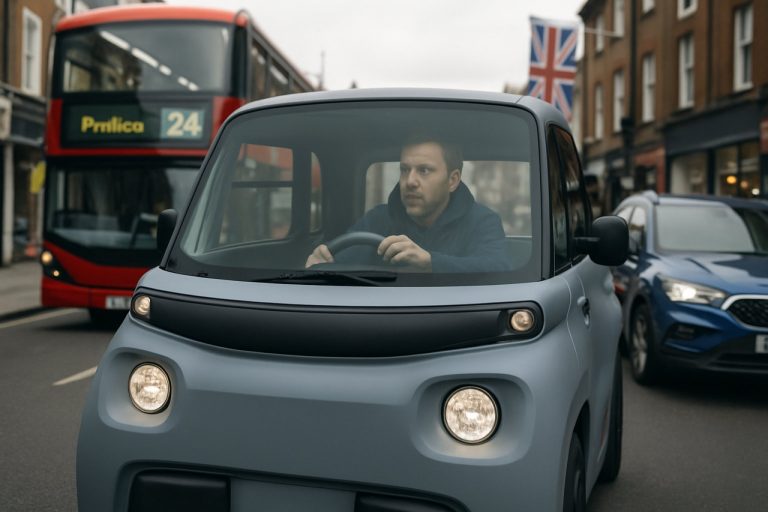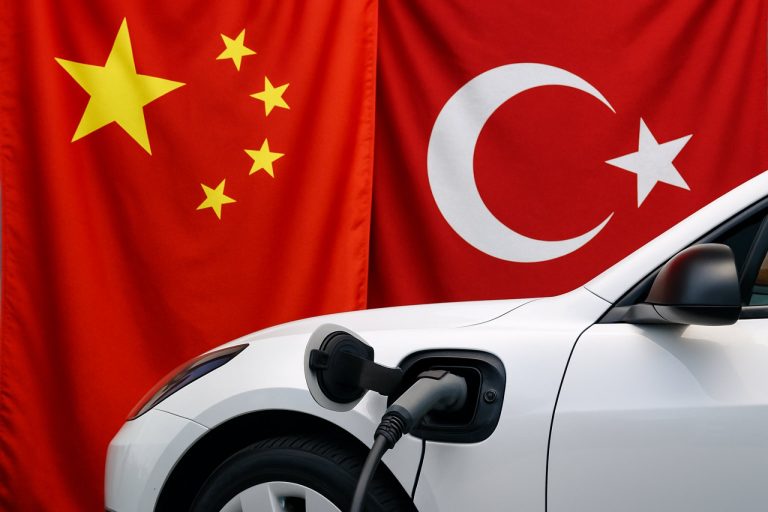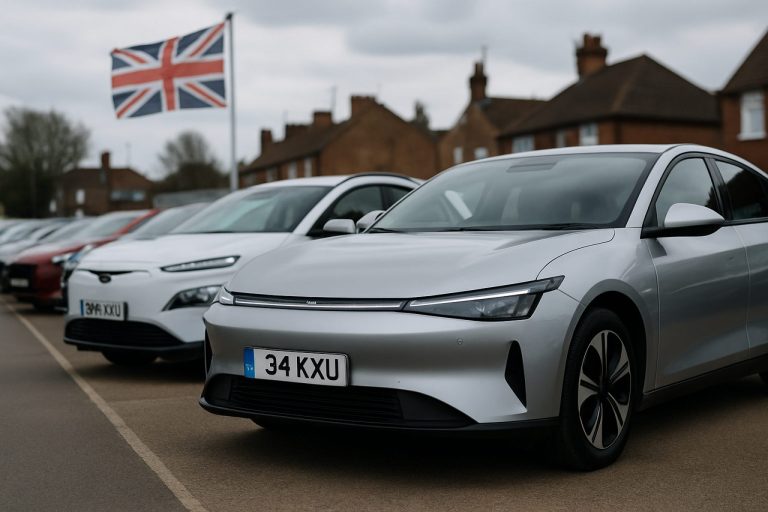
- China’s leading automakers, including BYD, have triggered a major electric vehicle (EV) price war, slashing prices by up to 30% and making entry-level EVs more affordable than ever.
- Average new car prices in China have dropped by about 19% in two years, with battery-electric and hybrid vehicles seeing even sharper declines.
- This intense competition squeezes profit margins, forcing smaller automakers toward consolidation or closure.
- EVs now make up nearly half of China’s new car sales, mostly by capturing market share from traditional gas-powered cars rather than expanding the overall market.
- International markets face the surge in low-cost Chinese EVs, prompting new tariffs in the U.S. and Europe, yet BYD continues to outpace rivals like Tesla in key regions.
- Automakers compete on technology and features, driving accelerated innovation in both price and standard equipment offered.
Sparks fly from factory floors to dealership showrooms as China’s automotive giants unleash a wave of electric car price cuts, jolting the global industry and setting off alarms from Detroit to Berlin. BYD, the world’s leading electric vehicle (EV) producer, has kicked off a bold round of discounts that see sticker prices on some models slashed by nearly 30%, catapulting the entry-level Seagull compact to just $7,750. Competitors like Geely and Great Wall Motors scramble to follow suit, igniting a fierce price war that’s reshaping the very core of the world’s largest car market.
The numbers are staggering. In just two years, average new car prices in China have dropped roughly 19% to around $22,900, according to recent industry analysis. Battery-powered and hybrid models have seen steeper declines—between 21% and an eye-watering 27%—while traditional gas-powered vehicles lag behind with a still notable 18% reduction. These cuts are a stark contrast to the trend in the United States, where car prices keep climbing and the average EV costs more than double its Chinese counterpart.
Across China, bustling showrooms in cities like Yantai now teem with curious customers, drawn by accessible price tags and sleek new models packed with technology. Yet beneath the surface optimism, the relentless push to grab market share comes at a cost. Smaller automakers, already straining under slender profit margins and tepid consumer demand, now teeter at the edge, fearing the fate of China’s infamous property developer Evergrande—a reminder of what happens when fierce expansion collides with fiscal reality.
This price-slashing spectacle is more than a short-term marketing stunt; it signals a structural shift. EVs now account for nearly half of all new passenger cars sold in China. However, this stellar double-digit growth does not reflect a surging market, but a changing landscape—EVs carved their gains from the shrinking market share of internal combustion engine vehicles, not from overall expansion. The pie isn’t getting much bigger; it’s just being sliced differently.
While China’s ruling party once spurred this revolution with generous subsidies, today’s policy winds have shifted. The market brims with state-backed and private startups, most now facing harsh consolidation. Some have survived by churning out affordable, tech-savvy vehicles, others have withered under mounting debts and cutthroat competition.
Globally, the reverberations are unmistakable. The European Union and the U.S. have imposed hefty tariffs on China-made EVs, citing unfair government support and the threat to local industries. Yet, Chinese EVs continue to surge across Europe—BYD even outsold Tesla in Europe for the first time in April, with Tesla’s own sales tumbling almost 50%. As BYD and its rivals set their sights worldwide, the aftershocks of China’s domestic dynamics are felt from the autobahns of Germany to Main Street USA.
Under pressure, automakers compete not just on price but on features. Some roll out advanced driver-assist systems as standard—a move that flips the traditional model of pricey add-ons upside-down. For buyers, it means more technology for less money, as brands fight tooth-and-nail for every customer.
China’s electric vehicle storm is far from over. Economic headwinds, government pressure to curb wasteful competition, and global protectionism paint an uncertain path ahead. What is clear: the battle being waged in China’s car lots is reshaping how the world buys, builds, and thinks about cars.
Bottom line: The current price war is not just about cheaper cars; it’s about accelerated innovation, market upheaval, and a global transformation led from China’s high-voltage showrooms. Any industry watching should brace themselves—this is just the beginning. For authoritative automotive news and developments, visit BYD and Tesla.
China’s EV Price War: Secrets the Headlines Won’t Tell You—What Every Car Buyer & Industry Insider Needs to Know
Unveiling the Deeper Layers of China’s Electric Car Price Revolution
China’s electric vehicle (EV) price war isn’t just setting off sparks across the globe—it’s triggering massive, lasting changes in how the world thinks about cars, technology, and economic power. This article unpacks the overlooked facts, essential data, and key questions about China’s automotive landscape, and delivers practical insights, life hacks, and actionable tips for car buyers and investors everywhere.
—
1. Real-World Use Cases: How Chinese EVs Are Changing Daily Life
– Urban Commuting Transformed: Ultra-affordable EVs like the BYD Seagull (starting at $7,750) enable first-time car ownership in China’s rapidly urbanizing cities. Many users now swap crowded public transport for clean, connected vehicles—drastically improving daily commutes.
– Fleet Electrification: Logistics, taxis, ride-hailing, and delivery services are rapidly shifting to EVs for lower operating costs. According to BloombergNEF, Chinese EVs now dominate new taxi and ride-share vehicle purchases in cities like Shenzhen and Chongqing.
– Rural Penetration: Mini-EVs (some under $5,000) are popular in less developed regions, breaking barriers to clean mobility.
2. Features, Specs & Pricing: Why Are These EVs So Cheap?
– Battery Innovation: Chinese firms like CATL and BYD manufacture advanced lithium-iron-phosphate (LFP) batteries in-house, slashing costs and boosting reliability. According to Reuters, LFP cells now cost up to 30% less than Western nickel-manganese-cobalt batteries.
– Software-Centric Design: Many Chinese EVs use integrated vehicle platforms, enabling over-the-air updates and in-car tech typically seen in $50,000+ Western models.
– Standard Advanced Safety: Features like adaptive cruise control, lane-keep assist, and automatic emergency braking are provided at base prices—whereas German or U.S. automakers charge thousands extra.
3. Security & Sustainability: Are These Cars Safe and Eco-Friendly?
– Crash Safety: Many new Chinese EVs meet or exceed Euro NCAP and Chinese NCAP crash safety standards. (Source: Euro NCAP reports)
– Battery Recycling: Companies like CATL lead in closed-loop battery recycling, improving sustainability metrics. China recycles more EV batteries (by volume) than any other nation.
– Cybersecurity: As with any connected car, privacy concerns exist—especially around data sharing. Buyers should review privacy and data protection policies.
4. Controversies, Limitations & Global Resistance
– Trade Tensions: The EU and U.S. have imposed tariffs of up to 100% on Chinese EVs, citing unfair subsidies and security risks. Expect higher prices or delayed model launches in North America and Europe—even as Chinese brands find ways to assemble cars locally to avoid tariffs.
– Market Consolidation: Smaller car companies are vanishing amid fierce price wars, echoing collapses like Evergrande’s in the real estate sector.
– Profit Squeeze: Some experts warn prices are now below sustainable levels. McKinsey & Company predicts a looming wave of bankruptcies and mergers by 2026.
5. Market Forecasts & Industry Trends
– China’s Lead in Battery Tech: By 2025, China is expected to account for nearly 70% of global lithium-ion battery production (Source: Benchmark Mineral Intelligence).
– Software-Driven Innovation: Chinese EVs are at the forefront of in-car AI voice assistants and infotainment. For example, NIO, XPeng, and BYD offer features not yet seen from American or European competitors.
– Export Booms: BYD exported 242,800 vehicles in 2023—a 334% year-on-year increase, targeting Latin America, Asia, and Europe.
6. Reviews & Comparisons: How Do Chinese EVs Stack Up Against Global Rivals?
Pros:
– Price-to-Feature Value: $8,000–$15,000 EVs with advanced tech
– Low Operating Costs: Electricity is often 60% cheaper than gasoline; maintenance is minimal
– Rapid Model Refreshes: New models launched every 6–12 months
Cons:
– Build Quality: Some buyers and reviewers report interior plastics and assembly standards lag behind European brands
– Brand Recognition: Outside China, many brands are still unknown or unproven
– Long-Term Reliability: Not yet clear how ultra-low-cost models will fare over 5–10 years
7. How-To Steps & Life Hacks: Buying a Chinese EV
1. Research Local Regulations: Many countries require additional homologation for Chinese cars. Check local dealer or importer options.
2. Battery Warranty: Look for a 6–8 year / 100,000-mile battery warranty or better—now often standard.
3. Connectivity Features: Assess in-car apps, over-the-air updates, and smartphone integration.
4. Consider Export Models: Companies like BYD and Tesla (for China-made models) are already present in Europe and South America with dealer support.
8. Most Pressing Questions—Answered
– Will these prices last?
– Unlikely. Price wars are expected to slow in 2025–2026 as weaker firms exit, leaving only strong players.
– Can Western automakers compete?
– Not easily. Without substantial cost and feature reductions, many must rethink their strategies or partner with Chinese firms.
– Are tariffs a long-term solution?
– Tariffs will delay, but not stop, Chinese EV expansion. Local assembly plants (almost all major Chinese firms are planning them in Europe and Asia) could sidestep protectionism.
9. Insights & Predictions
– Southeast Asia, Latin America, and Africa are poised to become massive growth markets for Chinese EVs—where EU/U.S. tariffs don’t apply.
– Car design will shift towards software-first, affordable models globally.
– Expect U.S. and European automakers to accelerate price cuts and tech upgrades in response.
—
Actionable Recommendations & Quick Tips
– For Buyers: If you are in a tariff-free country, now is the absolute best time to consider a Chinese EV for unbeatable value and features.
– For Investors: Focus on market leaders (BYD, Geely, NIO, XPeng) as they’re most likely to survive consolidation.
– For Automakers: Re-evaluate supply chains, battery partnerships, and R&D focus to counter the Chinese technological advantage.
– For Tech Enthusiasts: Watch for Chinese brands to pioneer next-gen smart driving platforms, infotainment, and AI tech.
—
Conclusion
China’s electric vehicle price war is not only building the world’s first mass market for affordable, technology-rich cars—it’s reshaping the entire global auto industry. Savvy buyers, investors, and policymakers should closely monitor this market for seismic shifts—and rethink how mobility, tech, and economics intertwine for the future.
For further updates, news, and the latest innovative models, stay tuned with trusted sources like BYD and Tesla.
Keywords: Chinese electric vehicles, BYD, EV price war, global auto market, car buying tips, car industry trends, Chinese car exports, affordable electric cars, battery technology, tariffs China, EV features, 2024 car market.



